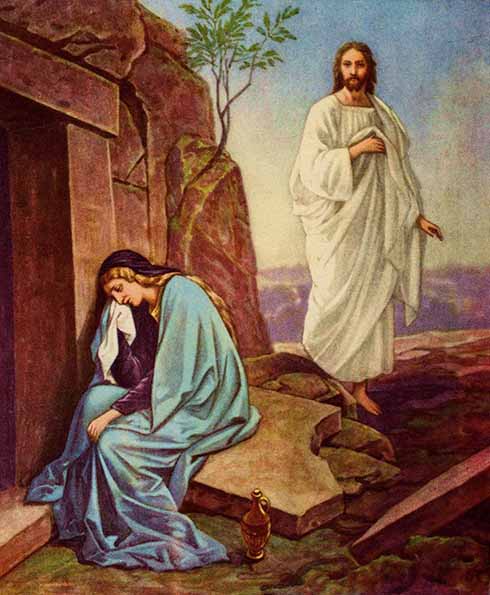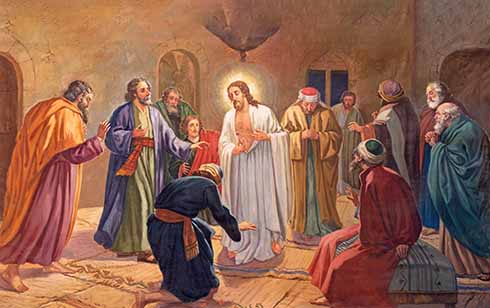Easter has always been the central Christian feast – it is more important even than Christmas. It celebrates Jesus’ rising from the dead after his terrible death. In the New Testament it is seen as the make-or-break belief. St Paul writes, ‘If Christ is not risen, our faith is in vain’. In this Explorations we reflect on why the Rising of Christ is so central in Christian faith. There have been two ways of explaining why it is so important.
 DOES JESUS’ RISING PROVE THAT FAITH IN HIM IS TRUE?
DOES JESUS’ RISING PROVE THAT FAITH IN HIM IS TRUE?
One way of explaining the importance of Jesus’ Resurrection, common in recent centuries, looks at it from outside. It claims that Jesus’ death on the cross proved that he was human. His rising from the dead, however, proved that he is God. It follows that all that Jesus said about himself, about our relationship to God and about the Church is true, and our faith is not in vain.
This approach to the Resurrection is part of the larger picture. After Jesus’ death Christians who commended their faith to others had to meet their doubts about whether Jesus really did rise from the dead. We see traces of this doubt in Mathew’s Gospel. He explains that the Jewish authorities paid the soldiers to say that Jesus’ disciples stole his body while the soldiers were asleep. The stories of the empty tomb and of Jesus’ appearances to his disciples also deal with scepticism about the Resurrection. They aim to show that Jesus’ rising did not just happen in the minds and perception of the early Christians. It was tangible and had real effects.
Belief that Jesus really rose from the dead remains central in Christian faith. The strongest argument for it lies in the weakness of the arguments against it. From the beginning Jesus’ Resurrection was the core of Christian faith. It relied on the evidence of Jesus’ disciples. Their faith in Jesus as the Messiah who would save his people must surely have been destroyed when he was executed. But it was not, and the disciples said that his rising made all the difference. Other explanations of why they did not become disillusioned and fade away after his death, but were filled with such energy and conviction to found a new movement, are all unconvincing.
CAN WE KNOW WHAT HAPPENED IN THE RESURRECTION?
The larger question that interested Paul and the other Christian preachers was what difference did Jesus’ rising make? They asked it from within their faith, not as outside observers. They did not give a scientific account of how Jesus rose. Nor did they think that such an account could be given. In meeting the risen Jesus they were taken into the mystery of God and of God’s world. In the stories of Jesus’ rising he remains mysterious. Angels pass on the news that the tomb is empty and tell his disciples what to do. He eats with his disciples but appears in locked rooms, is not at first recognised by his friends, is only seen by his disciples, knows what was said in his absence. He has risen into God’s world and allows us a glimpse of that world through our faith in him.
WHAT DIFFERENCE DID JESUS’ RESURRECTION MAKE TO HIS DISCIPLES?
When Paul argued that if Christ had not risen our faith would be in vain, he did not mean that our faith in Christ would be mistaken, but that it would not deliver the great hope that we had invested in it. For Paul and the early Christians Jesus’ Resurrection had made a life-changing difference to their lives. The stories in Scripture of Jesus’ Resurrection describe many of these changes and invite the readers to experience them too. They look at the Resurrection from inside.
When Jesus died his followers were not neutral observers. They had put their hopes in Jesus, had believed that he would be the Messiah, had left home and work to follow him, and had made friendships in which he was the centre. They were devastated by his death. They had lost everything. They feared that they might also be arrested, felt let down, and were perhaps determined never to be taken in again.
In the Gospel stories of Jesus’ Resurrection his disciples initially share this disillusionment. The stories were written for Christian communities, many of whose members had made huge sacrifices and faced large risks when they believed in Christ. Those who were Jews faced expulsion from the Jewish community and its rituals. All faced the threat of prosecution by the Roman officials which could end in torture and death. It would be natural for them to have had second thoughts about their faith.
The Gospel stories reminded them and later readers of the joy and excitement they had experienced when they found faith in Christ who was raised from the dead and was a living presence in their community. They are stories of encouragement that spell out the difference that that the Resurrection had made to their lives and to those of us later Christians. These are some of the ways in which the lives of Jesus’ disciples were changed.

THE MOVE FROM FEAR TO FAITH
In the Gospel stories the disciples are confused and afraid when they first hear of Jesus’ rising. The most likely ending of Mark’s Gospel describes three women visiting the tomb to anoint Jesus’ body after his crucifixion. They come wondering how they can roll away the stone that blocks the entry. They find the tomb empty, a young man in a white robe sitting inside who tells them that Jesus has risen and that they must tell Jesus’ disciples. They are terrified, however, and don’t tell anyone. Mark’s readers, of course, knew that the news had got around and that they themselves had come to believe in Christ’s rising.
We also see the move from fear and doubt to faith in other Gospel stories. In Luke’s Gospel the male disciples do not believe the women who have found the tomb empty. Whenever Jesus appears to his disciples he tells them not to be afraid. Thomas refuses to believe until he has rubbed shoulders with Jesus in the flesh. Slowly, however, the disciples move from fear and doubt to conviction and to hope in the promises Jesus had made. The Gospels invite us also to make the same move.
THE MOVE FROM GRIEF TO JOY
In the Easter stories, too, Jesus’ disciples move from grief to joy. In John’s Gospel Magdalene and other women stand by Jesus in helpless love and grief as he dies a tortured death. When Mary, longing for the consolation of touch, arrives at the tomb to anoint Jesus’ body only to find the tomb empty, her grief is doubled. In desperation she questions the supposed gardener, and recognises the voice and presence of Jesus. The story invites the readers to share the joyful hope of Mary and to see Christ’s presence even in the times of deepest sorrow and abandonment.
In many other stories, too, we see the move from distance, self-doubt and hesitation to intimacy and joy in Jesus’ company. When he joins the disciples, Jesus always introduces himself by saying, ‘Do not be afraid’. It is natural to fear ghosts, but the disciples’ hesitation also reflects their recognition that they had let Jesus’ down and were now in God’s presence. In the Easter stories they move from being servants to friends. Jesus speaks seriously to Peter who had denied him, and draws from him a love that is stronger than his failure. He also draws from Thomas a rich declaration of faith. Both apostles become comfortable and alive in Jesus’ presence.
 THE MOVE FROM ISOLATION TO COMMUNITY
THE MOVE FROM ISOLATION TO COMMUNITY
In the Easter stories the disciples change from being isolated and scattered to gathering together as friends. Luke describes two disciples who left their companions in Jerusalem and set out for Emmaus. They are sure it is all over with Jesus and his promises, and travel alone with their sadness. When Jesus joins them they do not recognise him. After asking them why they are so sad, he listens to their story, and then shows them that Jesus’ death was not the end but the prelude to his rising. Their hearts warmed, the disciples reach out to their fellow traveller, asking him to stay with them. As they break bread together, they recognise Jesus and hurry back to join the other disciples in Jerusalem to share the news of his rising.
We also find this shift from isolation to joy in Jesus’ company, from being alone to joining others, and from withdrawal to sharing life and mission in John’s story of Jesus’ appearance by the beach to his disciples. The disciples decide to go fishing. We are told that Thomas, the former loner, joined them. When Jesus appears on the beach, they listen to his instruction to cast their nets again and make a huge catch of fish, from which Jesus cooks their breakfast.
These stories speak of a movement from passivity to accepting the mission to go out to preach the Gospel of the crucified and risen Christ.
CHRISTIAN FAITH IN THE RISEN JESUS TODAY
The Resurrection stories remind us that Jesus is more than an inspiring person who once lived and died. He is also present with us as the Risen Christ. He invites us into a personal relationship with him. We can pray with and to him, and hear him speak freshly to us through the stories of his life. He is present with us in our life as a community in the Eucharist and other Sacraments and in our daily life in the Church. He is a ‘you’ to whom we speak and who accompanies us, and not just a ‘him’ whom we remember.
The Resurrection stories, too, tell us that Jesus conquers death and promises us that after our life on earth we shall join him in life with God. These are the promises Jesus made during his life on earth. The stories take us from a world closed in by death to a world that will be transformed and where we shall live an unimaginably happy life with Christ. Beyond the tent of our present world is a palace of justice, peace and love. Jesus spoke about this world in his preaching while on earth. He gives us a glimpse and confirmation of it in his rising from the dead and the stories of his meeting with his disciples.
CONCLUSION
In these reflections on Jesus’ rising from the dead we have tried to see it through the eyes of his disciples. For them it was the difference between hope and despair, between a world full of God’s presence and an empty world. His rising encourages us to pray to Jesus as friend and companion, and allows the Gospel stories to speak to us as God’s way of life.
QUESTIONS
- Why is it important for Christians to believe that Jesus really rose from the dead?
- If a photographer had been in the tomb, could she have taken a photo of his rising?
- How would Jesus’ disciples have felt after his crucifixion?
- How did Jesus’ Resurrection change the disciples’ lives?
- What is your relationship with the risen Jesus?
- What part does Jesus’ Resurrection play in belief in life after death?
REFLECTION QUESTIONS AND ACTIVITIES
Why does the Resurrection matter? Questions and activities
Explore the key events of the Resurrection and the disciples’ responses. Reflect on how their journey from fear to faith can deepen our understanding of what it means to live as Christians today.